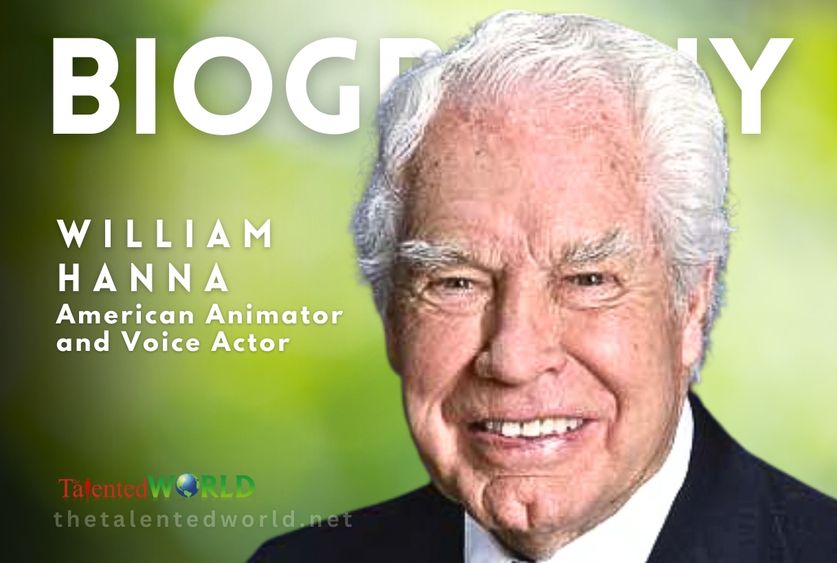
Quick Facts
| Quick Facts | Details |
|---|---|
| Full Name | William Denby Hanna |
| Date of Birth | July 14, 1910 |
| Place of Birth | Melrose, New Mexico Territory, U.S. |
| Date of Death | March 22, 2001 |
| Place of Death | Los Angeles, California, U.S. |
| Resting Place | Ascension Cemetery, Lake Forest, California, U.S. |
| Other Names | Bill Hanna |
| Occupations | Animator, Musician, Voice Actor |
| Years Active | 1930–2001 |
| Notable Works | Tom and Jerry, The Ruff and Reddy Show, The Flintstones, The Jetsons, The Yogi Bear Show, The Huckleberry Hound Show |
| Spouse | Violet Wogatzke (married in 1936) |
| Children | 2 |
| Co-Founder of | Hanna-Barbera Productions |
| Awards | 7 Academy Awards, 8 Emmy Awards |
| Early Career | Joined Harman and Ising animation studio in 1930 |
| Significant Collaboration | Met Joseph Barbera at MGM in 1937 |
| Major Achievement | Co-creator of Tom and Jerry |
| Studio Sale | Hanna-Barbera sold to Taft Broadcasting in 1967 for $12 million |
| Later Career | Hanna-Barbera sold to Turner Broadcasting System in 1991 and later merged with Time Warner in 1996 |
| Early Life | Third of seven children frequently moved due to father’s construction work |
| Education | Attended Compton High School and Compton City College |
| Boy Scouts | Became an Eagle Scout, Scoutmaster, awarded Distinguished Eagle Scout Award in 1985 |
| Hobbies | Sailing, singing in a barbershop quartet |
| Marriage | Married Violet Blanch Wogatzke for over 64 years |
| Autobiography | Published with assistance from Tom Ito in 1996 |
| Legacy | Hanna-Barbera’s cartoons are cultural icons with a global audience |
| Cultural Impact | Created beloved characters and shows with worldwide recognition |
| Personal Attributes | Described his family as “a red-blooded, Irish-American family” |
William Hanna Movies
| Movies and Shows by William Hanna | Year |
|---|---|
| Tom and Jerry | 2021 |
| The Yogi Bear Show | 1961 – 1962 |
| The Huckleberry Hound Show | 1958 – 1961 |
| Puss Gets the Boot | 1940 |
| The Tom and Jerry Show | 1975 |
| The Flintstones | 1960 – 1966 |
| Tom and Jerry: The Movie | 1992 |
| The Jetsons | 1962 – 1963 |
| The Quick Draw McGraw Show | 1959 – 1961 |
| Tom and Jerry Tales | 2006 – 2008 |
| Tom & Jerry Kids | 1990 – 1993 |
| Top Cat | 1961 – 1962 |
| The Night Before Christmas | 1941 |
| The Midnight Snack | 1941 |
| Wacky Races | 1968 – 1969 |
| Jonny Quest | 1964 – 1965 |
| The New Scooby-Doo Movies | |
| Pixie and Dixie and Mr. Jinks | 1958 – 1961 |
| Tom and Jerry: The Fast and the Furry | 2005 |
| The Tom and Jerry Comedy Show | 1980 |
| The Magilla Gorilla Show | 1964 – 1965 |
| Tom and Jerry: The Magic Ring | 2001 |
| Scoob! | 2020 |
| Tom and Jerry Spotlight Collection | |
| The New Yogi Bear Show | 1988 |
| Wally Gator | 1962 – 1963 |
| Jetsons: The Movie | 1990 |
| The Secret Squirrel Show | 1965 – 1966 |
| Blue Cat Blues | 1956 |
| I Yabba-Dabba Do! | 1993 |
| Dastardly and Muttley in Their Flying Machines | 1969 – 1970 |
| Augie Doggie and Doggie Daddy | 1959 – 1961 |
| The Cat Concerto | 1947 |
| Tom And Jerry: Shiver Me Whiskers | 2006 |
| The Ruff and Reddy Show | 1957 – 1960 |
| Tom e Jerry Encontram Sherlock Holmes (Dublado) | 2010 |
| Tom & Jerry: A Nutcracker Tale | 2007 |
| The Yankee Doodle Mouse | 1943 |
| Hey There, It’s Yogi Bear! | 1964 |
| The Karate Guard | 2005 |
| Mouse Trouble | 1944 |
| Snooper and Blabber | 1959 – 1961 |
| Baby Puss | 1943 |
| The Two Mouseketeers | 1952 |
| The Man Called Flintstone | 1966 |
| The Jetsons Meet the Flintstones | 1987 |
| Tom and Jerry Special Shorts | Since 2021 |
| Saturday Evening Puss | 1950 |
| Scooby-Doo | 2002 |
| Tom and Jerry: Blast Off to Mars | 2005 |
| Hokey Wolf | 1960 – 1961 |





